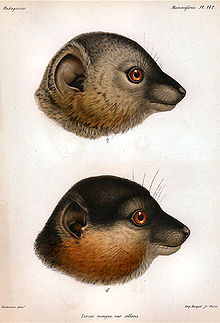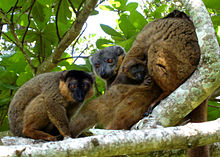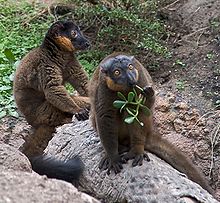- Collared brown lemur
-
Collared brown lemur[1] 
collared brown lemurs:
Female (top) and male (bottom)
(Illustration from 1892)Conservation status Scientific classification Kingdom: Animalia Phylum: Chordata Class: Mammalia Order: Primates Suborder: Strepsirrhini Infraorder: Lemuriformes Family: Lemuridae Genus: Eulemur Species: E. collaris Binomial name Eulemur collaris
É. Geoffroy, 1817
Collared brown lemur range Synonyms - melanocephala Gray, 1863
- xanthomystax Gray, 1863
The collared brown lemur (Eulemur collaris), also known as the red-collared brown lemur or red-collared lemur, is a medium-sized strepsirrhine primate and one of twelve species of brown lemur in the Lemuridae family. It is only found in south-eastern Madagascar. Like most species of lemur, it is arboreal, moving quadrupedally and occasionally leaping from tree to tree. Like other brown lemurs, it lives in social groups, primarily eats fruit, is active both day and night, exhibits sexual dichromatism, and does not demonstrate female dominance. The species is listed as Vulnerable by the International Union for Conservation of Nature (IUCN) and is threatened primarily by habitat loss.
Contents
Taxonomy
Together with the twelve other true lemurs (genus Eulemur),[3] the collared brown lemur (E. collaris) is a type of lemur belonging to the family Lemuridae. Collectively, lemurs (infraorder Lemuriformes) are classified as strepsirrhine primates. Originally listed as a subspecies of the common brown lemur (E. fulvus), the collared brown lemur was promoted to full species status in 2001 by biological anthropologist Colin Groves.[1]
Anatomy and physiology
An adult collared brown lemur can reach a head-body length of 39 and 40 cm (15 and 16 in) and have a tail length of 50 and 55 cm (20 and 22 in) for an overall length of 89 and 95 cm (35 and 37 in). It has an average body weight of 2.25 and 2.5 kg (5.0 and 5.5 lb), making it a medium-sized lemur.[4][5] The only form of sexual dimorphism exhibited by the collared brown lemur is dichromatism. The following table illustrates the coloration differences between the sexes:
Differences in coloration between sexes in the collared brown lemur[4][5] Male Female Dorsal coat Brownish-gray Browner and more rufous than the male's Ventral coat Paler gray Pale creamy-gray Tail Darker gray with a dark stripe along the spine Same as dorsal coat Face and head Muzzle, face and crown are dark gray to black; creamy to gray-colored eyebrow patches vary between individuals Gray, with faint gray stripe extending over crown Cheeks Creamy to rufous-brown cheeks and beard are thick and bushy Rufous-brown, but less prominent than the male's Eyes orange-red orange-red In the wild, the collared brown lemur's range does not overlap with other brown lemurs, so it is rarely confused with other species.[5] However, in captivity it can be easily confused with the gray-headed lemur (Eulemur cinereiceps) due to similar coloration. The male collared brown lemur can be distinguished by their cream-colored or rufous beards, whereas the male gray-headed lemur has a white beard. Females of these two species are nearly indistinguishable, even though genetic analyses support full species status for both taxa.[4]
Ecology
Found in tropical moist lowland and montane forests in southeastern Madagascar, the collared brown lemur occurs west to the forests of Kalambatritra and in the south from Tôlanaro north to the Mananara River.[2][4][5] The Mananara River is the boundary between the ranges of the collared brown lemur and the Gray-headed Lemur to the north. The collared brown lemur can be seen in the Mandena Conservation Zone, Saint Luce Private Reserve, and Andohahela National Park.[4]
In its environment, the collared brown lemur acts as a seed disperser, and is especially critical for the dispersal of large-seeded fruiting trees within its range.[6] However, there is no evidence that these relationships are coevolutionary and instead these lemurs may be the last remaining seed dispersers for these tree species following the extinction of larger frugivorous birds and subfossil lemurs.[7]
Behavior
Very little is known about this species. It is thought to primarily eat fruit, like most other true lemurs.[4] It is also cathemeral (active both day and night throughout the year), a trait seen in some other members of its genus.[4][5] Research has suggested that metabolic dietary-related needs are the leading factor behind this behavior, although the specific hours of this activity pattern can shift based on lunar luminosity and seasonal changes in the photoperiod (day length).[8] Previous studies had ruled out effects of predators on the expression of this trait, and instead pointed to fruit availability and fiber intake as more important factors.[9]
The collared brown lemur tends to live in social groups that are multi-male/multi-female,[4] with groups ranging in size from three to seven.[5] Population densities are estimated at 14 individuals/km2, and it appears to be common within its range.[4] Females give birth to one offspring between October and December, and male involvement with the young has been observed.[5] Female dominance, a common behavioral trait in many lemur species but uncommon in most true lemurs, has not been observed in this species.[4][10]
Brown lemurs at Berenty (hybrid E. fulvus x collaris) [11] show linear hierarchy, adult female dominance, and the presence of conciliatory behavior after aggressions.[12] Additionally, stress levels (measured via self-directed behaviors) decrease at the increase of the hierarchical position of individuals within the social group and reconciliation is able to bring stress down to the baseline levels.[13]
Conservation status
The collared brown lemur was listed as Vulnerable (VU A2cd) in the 2008 IUCN Red List assessment.[2] Its greatest threat is habitat loss from slash-and-burn agriculture and charcoal production. It is also hunted for food and captured for the local pet trade.[4] Populations of the collared brown lemur have been successfully sustained in captivity as a safeguard against their extinction.[14]
A small group of collared brown lemurs was introduced in the 1980s into the Berenty Private Reserve and has since hybridized with introduced red-fronted lemurs.[4]
References
- ^ a b Groves, C. (2005). "Eulemur collaris". In Wilson, D. E., & Reeder, D. M, eds. Mammal Species of the World (3rd ed.). Baltimore: Johns Hopkins University Press. OCLC 62265494. ISBN 0-801-88221-4. http://www.bucknell.edu/msw3/browse.asp?id=12100038.
- ^ a b c Andrainarivo, C., Andriaholinirina, V. N., Feistner, A., Felix, T., Ganzhorn, J., Garbutt, N., Golden, C., Konstant, B., Louis Jr., E., Meyers, D., Mittermeier, R. A., Perieras, A., Princee, F., Rabarivola, J. C., Rakotosamimanana, B., Rasamimanana, H., Ratsimbazafy, J., Raveloarinoro, G., Razafimanantsoa, A., Rumpler, Y., Schwitzer, C., Thalmann, U., Wilmé, L. & Wright, P. (2008). Eulemur collaris. In: IUCN 2008. IUCN Red List of Threatened Species. Downloaded on 1 January 2009.
- ^ Mittermeier, R.; Ganzhorn, J.; Konstant, W.; Glander, K.; Tattersall, I.; Groves, C.; Rylands, A.; Hapke, A. et al. (2008). "Lemur Diversity in Madagascar". International Journal of Primatology 29 (6): 1607–1656. doi:10.1007/s10764-008-9317-y.
- ^ a b c d e f g h i j k l Mittermeier, R.A.; Konstant, W.R.; Hawkins, F.; Louis, E.E.; Langrand, O.; Ratsimbazafy, J.; Rasoloarison, R.; Ganzhorn, J.U. et al. (2006). Lemurs of Madagascar. Illustrated by S.D. Nash (2nd ed.). Conservation International. pp. 278–279. ISBN 1-881173-88-7.
- ^ a b c d e f g Garbutt, N. (2007). Mammals of Madagascar, A Complete Guide. A&C Black Publishers. pp. 164–165. ISBN 978-0-300-12550-4.
- ^ Bollen, A.; Van Elsacker, L.; Ganzhorn, J.U. (2004). "Relations between fruits and disperser assemblages in a Malagasy littoral forest: a community-level approach". Journal of Tropical Ecology (Cambridge University Press) 20 (6): 599–612. doi:10.1017/S0266467404001853.
- ^ Bollen, A.; Van Elsacker, L.; Ganzhorn, J.U. (2004). "Tree dispersal strategies in the littoral forest of Sainte Luce (SE-Madagascar)". Oecologia (Springer Berlin / Heidelberg) 139 (4): 604–616. doi:10.1007/s00442-004-1544-0. PMID 15095087.
- ^ Donatia, G.; Baldib, N.; Morellib, V.; Ganzhorn, J.U.; Borgognini-Tarli, S.M. (2009). "Proximate and ultimate determinants of cathemeral activity in brown lemurs". Animal Behaviour 77 (2): 317–325. doi:10.1016/j.anbehav.2008.09.033.
- ^ Donati1, G.; Bollen, A.; Borgognini-Tarli, S.M.; Ganzhorn, J.U. (2007). "Feeding over the 24-h cycle: dietary flexibility of cathemeral collared lemurs (Eulemur collaris)". Behavioral Ecology and Sociobiology (Springer Berlin / Heidelberg) 61 (8): 1237–1251. doi:10.1007/s00265-007-0354-x.
- ^ Sussman, R. (1999). Primate Ecology and Social Structure Volume 1: Lorises, Lemurs and Tarsiers. Pearson Custom Publishing. p. 214. ISBN 0-536-02256-9.
- ^ Alison Jolly, Naoki Koyama, Hantanirina Rasamimanana, Helen Crowley, and George Williams (2006). "Berenty Reserve: a research site in southern Madagascar". In A. Jolly, R. W. Sussman, N. Koyama & H. Rasamimanana. Ringtailed Lemur Biology: Lemur catta in Madagascar. pp. 32–42. ISBN 0387326693.
- ^ Norscia, I., Palagi, E. (2010). "Do wild brown lemurs reconcile? Not always". Journal of Ethology. doi:10.1007/s10164-010-0228-y.
- ^ Palagi, E., Norscia, I. (2010). "Scratching around stress: hierarchy and reconciliation make the difference in wild brown lemurs Eulemur fulvus". Stress. doi:10.3109/10253890.2010.505272.
- ^ "ISIS Species Holdings, Eulemur collaris". International Species Information System (ISIS). 2010. http://app.isis.org/abstracts/abs.asp. Retrieved 26 February 2010.
Extant species of family Lemuridae Lemur Eulemur
(True lemurs)Black Lemur (E. macaco) · Common Brown Lemur (E. fulvus) · Sanford's Brown Lemur (E. sanfordi) · White-headed Lemur (E. albifrons) · Red-fronted Lemur (E. rufifrons) · Red Lemur (E. rufus) · Collared Brown Lemur (E. collaris) · Gray-headed Lemur (E. cinereiceps) · Mongoose Lemur (E. mongoz) · Crowned Lemur (E. coronatus) · Red-bellied Lemur (E. rubriventer) · Sclater's Lemur (E. flavifrons)Varecia
(Ruffed lemurs)Hapalemur
(Bamboo lemurs)Prolemur CategoryCategories:- IUCN Red List vulnerable species
- True lemurs
Wikimedia Foundation. 2010.



